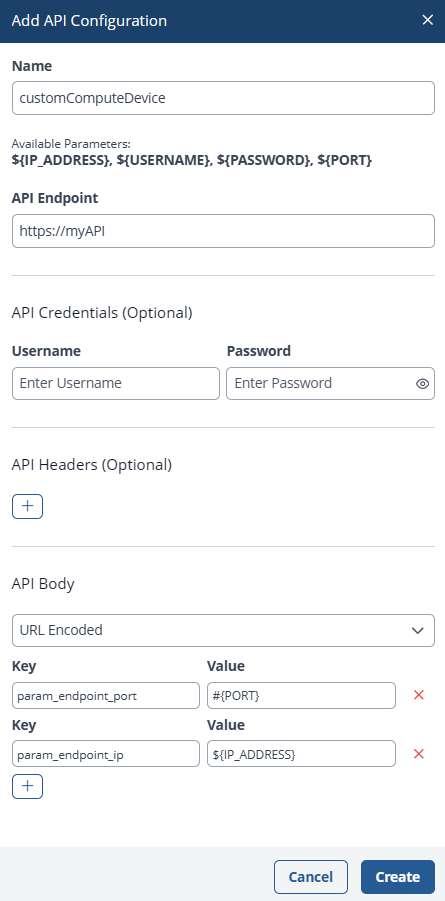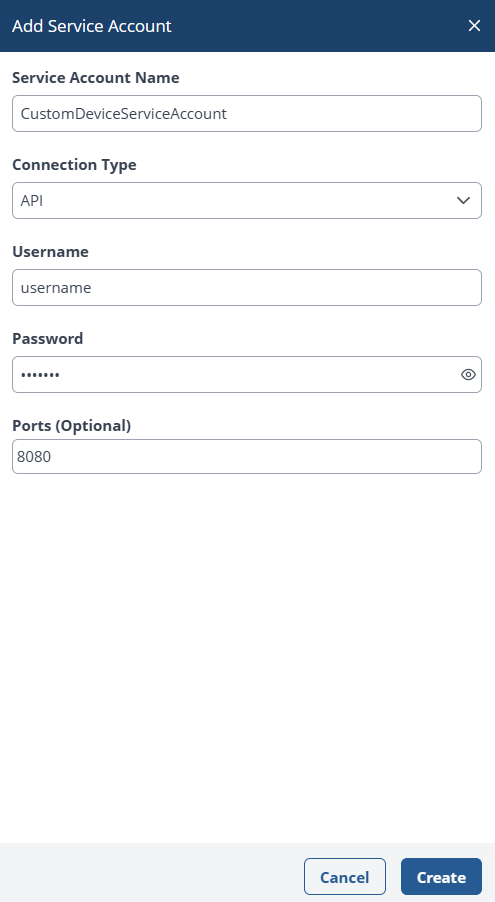Custom Device Configuration
Despite the vast range of over 100 device types offered by Resolve Insights, the discovery process might still fail to identify a new type of device or a custom device.
With Custom Device Configuration, you can define your own custom device types, describing how they could be identified. You can create as many custom device configurations as you want, edit them, and delete them.
Available Custom Device Discovery Methods
Depending on the type of custom device that you want to discover, Insights provides these discovery methods:
- API: Use this method if the custom device has a purpose-built API. You’ll need to provide the API endpoint details so Insights can make the call. Only REST APIs that return a JSON device description are supported.
- Python Script: If the device lacks a suitable API, you can define its details and properties using the Insights Python SDK.
Create a Custom Device Configuration
Navigate to Organization Settings > Custom Device Configuration.
Click + Add Configuration.
Select configuration type from the dropdown - Script or API.
Enter the configuration Name and fill in the details:
Python Script (for Script configuration type): Enter the Python code that connects to the device type and identifies it in Insights. You can describe only one device type per configuration.
API (for API configuration type): Enter the API endpoint details. This configuration can support multiple device types of the API allows it, but only one endpoint can be used per configuration. Fill in the following fields:
- API Endpoint — Enter the API endpoint, prefixed with
https://orhttp://. - (Optional) API Credentials — If authentication is required, enter the username and the password.
noteOnly basic authentication is supported.
- (Optional) API Headers - Enter the HTTP headers required by the API as key-value pairs. Use the minus sign to remove pairs. You can use placeholders for common data.
- API Body - Select the content type (
URL EncodedorJSON) and enter the body data as key-value pairs. Add more pairs with the plus sign and remove them with the minus sign. At least one key-value pair is required. You can use placeholders for common data.
- API Endpoint — Enter the API endpoint, prefixed with
Click Create to complete the new custom device configuration.
Placeholder Usage
Placeholders allow you to substitute common values on the fly instead of entering them directly.
There are two categories of placeholders that you can use with custom device discovery:
- Service account references
- Reference to the IP address of a device

Service Account References
This category makes managing your custom device configurations easier. Instead of entering common authentication details multiple times, you can refer to an existing service account using these placeholders. This way, when you update the service account, all custom device configurations that refer to it will automatically update.
The category includes the following placeholders:
${USERNAME}—Refers to the value of the service account's USERNAME field.${PASSWORD}—Refers to the value of the service account's PASSWORD field.${PORT}—Refers to the value of the service account's PORTS field. In case multiple port numbers are present, Insights gives each one a try until it makes a successful connection.
Go to Discovery > Service Accounts to create or edit service accounts.

IP Address Reference
This category includes a placeholder that refers to the list of IP addresses (IPv4 and IPv6) specified during discovery using the Discovery > Device Discovery > Single > Custom Configuration > IP Settings > FQDN/IP List option. It is useful for narrowing down the devices returned by the custom device's discovery API.
${IP_ADDRESS}
Edit a Custom Device Configuration
- Navigate to Organization Settings > Custom Device Configuration.
- In the Actions column for the configuration that you want to change, click the Edit (pencil) icon.
- Make your changes.
- Click Save.
Delete a Custom Device Configuration
- Navigate to Organization Settings > Custom Device Configuration.
- Depending on the number of configurations that you want to delete, do the following:
- If deleting a single configuration, in the Actions column for the configuration change, click the Delete (trashcan) icon.
- If deleting multiple configurations, select their respective rows in the table and click the Delete toolbar button.
Find Discoveries of a Custom Device Configuration
If you are interested in finding out which of the device discovery schedules include a specific custom device configuration, you can do this from the configuration's properties.
One-time discovery requests and expired schedules do not appear on the list.
- Navigate to Organization Settings > Custom Device Configuration.
- In the Actions column for the configuration that you want to view, click the Used In (info) icon. The active schedules in which this configuration is included are listed.
To view more about the schedules or to edit them, go to the Discovery screen.